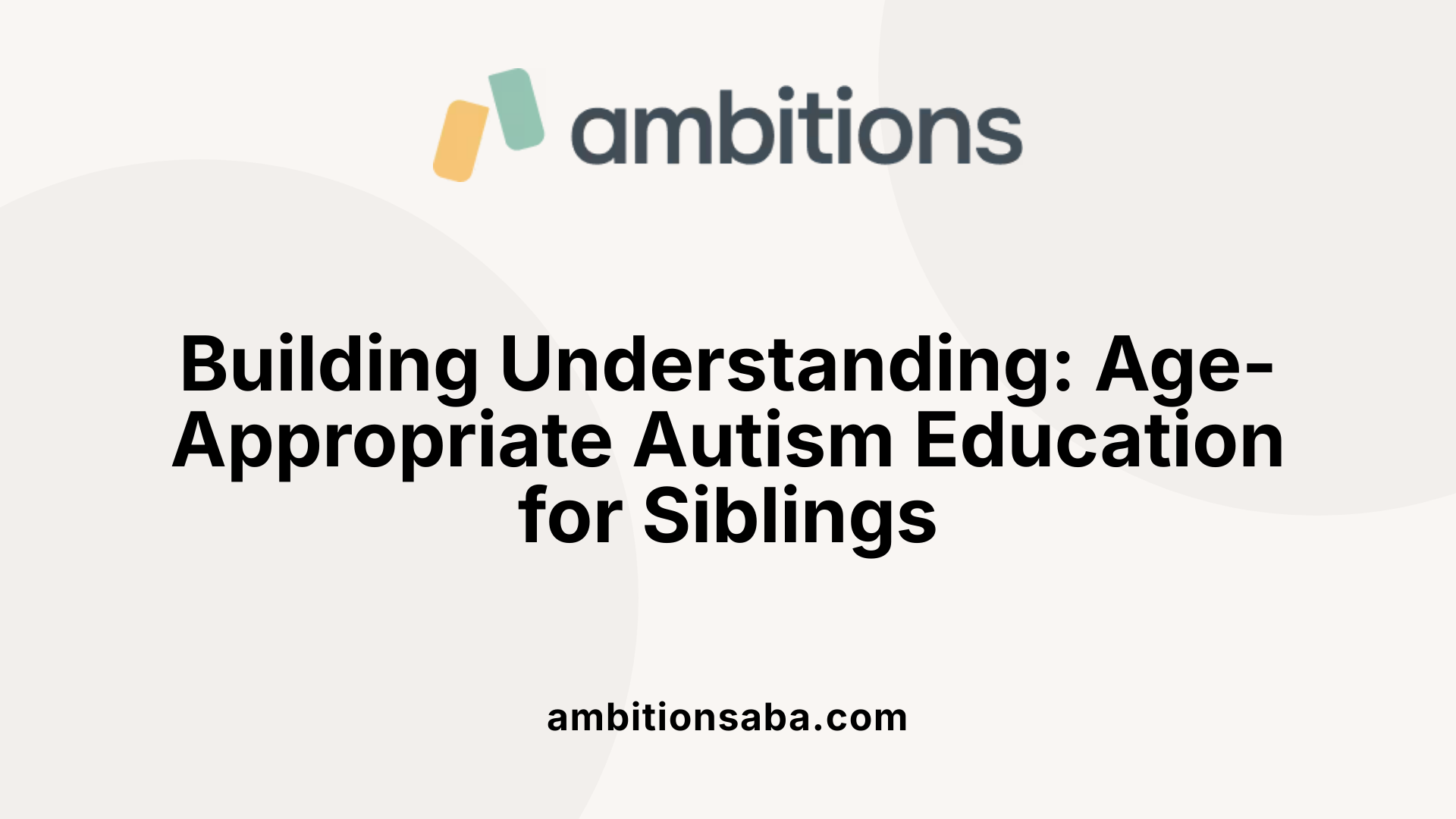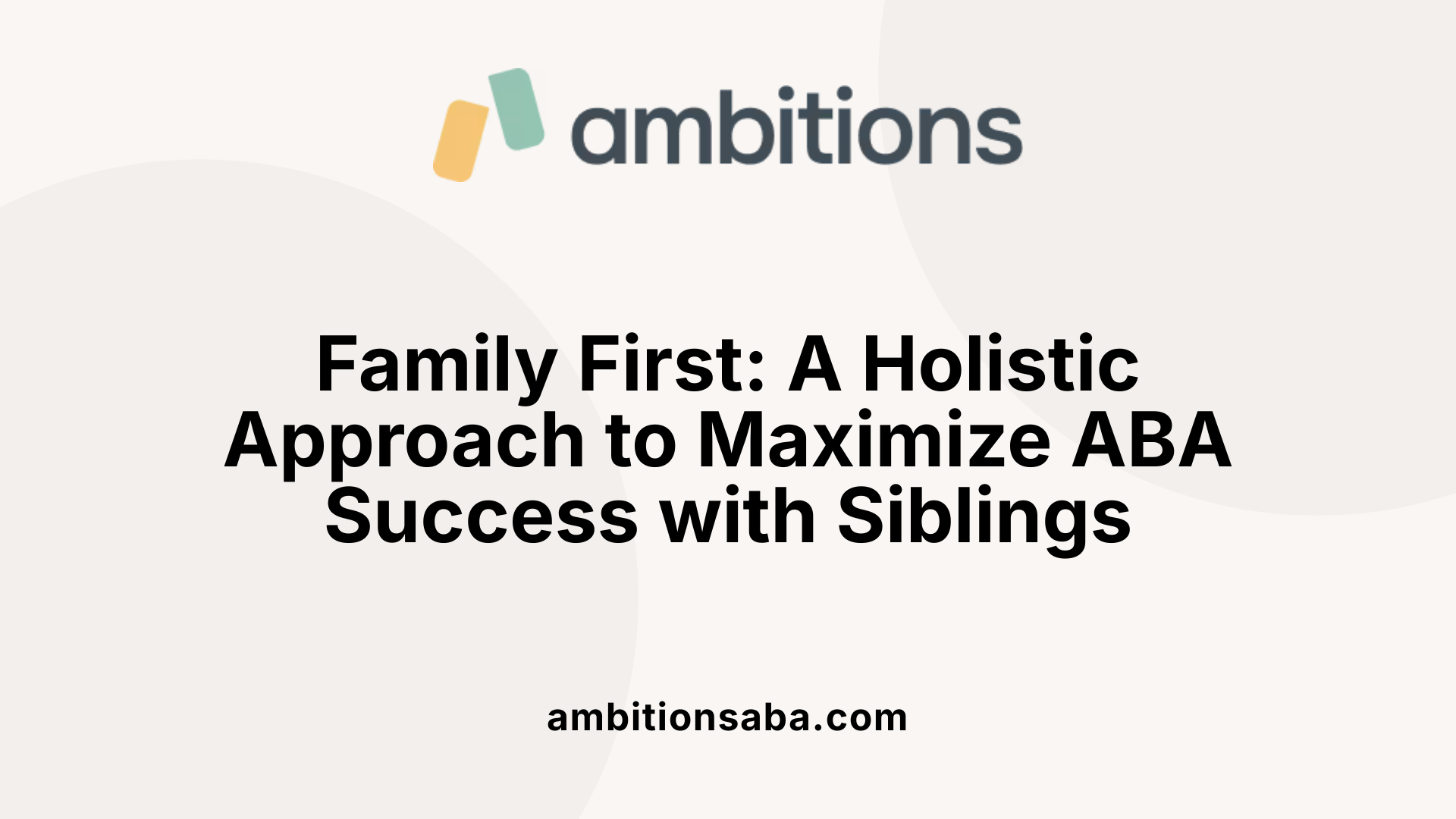Unlocking Developmental Potential Through Behavior Cusps
Understanding the Importance of Siblings in Autism Therapy
Involving siblings in the ABA (Applied Behavior Analysis) journey is not just beneficial but essential for maximizing therapeutic success and strengthening family bonds. When siblings are engaged meaningfully, they gain a better understanding of autism, learn how to support their brother or sister, and develop empathy and patience. This article explores practical ways to include siblings in ABA activities, the benefits of their involvement, strategies for teaching them about autism, and effective methods to nurture positive sibling relationships within the context of ABA therapy.
Involving Siblings in ABA Activities Practically

How can parents practically engage siblings in ABA activities and support their inclusion during therapy?
Involving siblings in ABA therapy can significantly benefit both the child with autism and their brothers or sisters. Parents can encourage participation by incorporating siblings into structured play that emphasizes social skills, such as turn-taking, sharing, and cooperative games like building blocks or group storytelling.
Educating siblings about autism using simple, age-appropriate explanations or social stories is essential. This understanding fosters empathy and promotes positive interactions. For example, explaining that their sibling may have different needs and behaviors helps children become more patient and supportive.
Daily routines and family activities present natural opportunities for practicing ABA skills. Cooking together, outdoor games, or joint art projects allow siblings to reinforce communication and social engagement in real-life settings.
Role-playing scenarios and modeling appropriate behaviors are effective strategies. Parents can demonstrate how to greet their sibling, offer prompts for social interaction, or praise cooperative behavior with high-fives or verbal praise.
Inclusion in therapy sessions can be arranged where suitable, allowing siblings to observe and even participate in specific activities. This involvement supports teamwork and strengthens emotional bonds.
Respecting individual boundaries is crucial. Children should feel comfortable declining participation or taking breaks when needed, ensuring a positive experience for everyone.
Overall, fostering an environment where siblings actively participate, guided by positive reinforcement and patience, enhances social learning, builds understanding, and promotes family unity.
Teaching Siblings About Autism to Build Support and Understanding

What are some effective ways to teach siblings about autism to foster understanding and support?
Educating siblings about autism in an accessible and compassionate way is essential for fostering acceptance and support within the family. Using age-appropriate explanations helps children grasp the basics of autism without feeling overwhelmed. For younger siblings, simple language and concrete examples work best, such as explaining that autism is a way a child's brain works differently, affecting how they communicate or play.
Incorporating children’s books, social stories, and visual aids makes complex concepts easier to understand and engages siblings actively. These tools can illustrate everyday situations, social cues, and appropriate responses, fostering empathy and patience. For example, reading books about autism can normalize the condition and highlight the strengths of autistic individuals.
Open dialogue is crucial. Families are encouraged to encourage questions, listen to their children's feelings, and share their own thoughts. This openness helps siblings process their emotions, address misconceptions, and build a stronger emotional connection.
Discussions about future caregiving or support roles also prepare siblings emotionally and practically. Talking about ways they can help, support, or simply be understanding promotes a team effort and reduces potential feelings of resentment or confusion.
Engagement through shared activities—like cooperative play, participating in therapy exercises, or joint outings—can strengthen bonds. Connecting with autism support groups and community resources provides additional learning opportunities and emotional backing.
Ultimately, these strategies foster a positive environment where siblings can develop empathy, patience, and acceptance, becoming active and supportive members of their family’s autism journey.
Strategies for Engaging Siblings in ABA and Their Benefits

What are effective strategies for involving siblings in ABA therapy, and what are the benefits of sibling involvement?
Including siblings in ABA therapy can make a significant difference in the progress of a child with autism and strengthen family bonds. One effective approach is educating siblings about autism, helping them understand their sibling’s behaviors and needs. This promotes empathy and reduces misunderstandings.
Invite siblings to participate in therapy-related activities. For example, they can join in structured play or practice social skills like turn-taking and joint attention through games such as 'Simon Says' or building blocks. Such involvement not only reinforces learned skills but also makes therapy a family experience.
Encouraging positive and respectful interactions is vital. Siblings can provide reinforcement through praise, high-fives, or access to special toys, which encourages the child's development in a natural, engaging way.
Shared routines, like mealtime or clean-up time, are perfect opportunities to practice ABA skills and promote consistency. These real-life settings help children generalize skills beyond therapy sessions.
Celebrating individual differences and promoting patience foster a supportive environment. When siblings are involved respectfully and without over-responsibility, it enhances the family’s overall harmony.
The benefits of sibling involvement go beyond supporting the child with autism. Siblings often develop deeper understanding, more empathy, and stronger emotional bonds. They learn valuable social skills and gain confidence in engaging positively.
This active participation can also create a nurturing family dynamic, making the home a more inclusive place. Overall, involving siblings in ABA programs aids in reinforcing therapy goals while promoting family unity.
Supporting Siblings to Foster Positive Relationships in ABA Context

How can families support and strengthen sibling relationships during ABA therapy?
Supporting siblings effectively involves fostering open communication and emotional validation. Encouraging children to share their feelings and concerns about their sibling with autism helps them feel heard and understood. It’s also essential to educate siblings with age-appropriate language about autism and the goals of ABA therapy. This understanding nurtures acceptance, patience, and empathy.
Shared activities and structured family routines play a significant role in building bonds. Cooperative play games, joint storytelling, and engaging in routines such as mealtime or clean-up create opportunities for siblings to practice social skills learned in ABA, like turn-taking and patience. These activities foster teamwork and help normalize the experience, making everyone feel involved.
Reinforcing social skills involves encouraging patience, sharing, and positive interactions. Siblings can model and practice these behaviors during play or daily routines. Recognizing and celebrating small successes together promotes a sense of accomplishment and familial unity.
External support and resources are also beneficial. Support groups, educational resources, and professional guidance can provide siblings with strategies to navigate challenges without feeling overwhelmed. Regular family activities that celebrate progress and acknowledge each child's individual needs contribute to a supportive environment.
In summary, promoting open dialogue, engaging in shared activities, reinforcing social skills, and seeking external support are effective methods to nurture positive sibling relationships amidst ABA therapy. Creating an inclusive, understanding, and supportive family atmosphere enhances both the child's development and sibling bonds.
Creating a Family-Centered Approach to Maximize ABA Success

Why is sibling involvement important in ABA therapy, and how does it impact the child's development?
Involving siblings in ABA therapy is essential for supporting the child's growth and strengthening family bonds. When siblings are included in therapy goals and everyday routines, they become active participants, which fosters empathy, patience, and mutual understanding.
This inclusion helps generalize skills learned during therapy to real-life situations. Siblings can support the child's development by practicing social skills, reinforcing positive behaviors, and understanding non-verbal cues.
Moreover, involving siblings promotes a cohesive family environment. It reduces stigma around autism and encourages a sense of normalcy. Celebrating each child's uniqueness and creating shared routines help build a sense of shared purpose and belonging.
By fostering family unity and encouraging sibling participation, ABA programs become more effective. This collaborative approach not only benefits the child's developmental outcomes but also nurtures a supportive and understanding family dynamic.
How does involving the whole family, including siblings, support therapy goals?
Family involvement in ABA involves establishing routines that include siblings, encouraging participation, and reinforcing skills at home. Structured play and shared activities like games or storytelling help siblings practice social cues, turn-taking, and engagement.
Siblings can also be trained to provide reinforcement through praise and rewards, which strengthens their relationship and supports therapy goals.
Creating opportunities during everyday routines—such as meal times or family chores—allows siblings to incorporate ABA strategies naturally. This integration ensures consistency across settings, promoting better skill generalization.
How can ABA therapy help strengthen sibling relationships?
ABA techniques such as teaching effective communication, social interaction, and emotional regulation are designed to foster better sibling understanding. These skills help siblings recognize and respond appropriately to each other's cues.
ABA can also reduce problematic behaviors, making interactions more positive. Engaging siblings in structured play and cooperative activities can boost their social skills, patience, and empathy.
Teaching siblings about autism through age-appropriate explanations and social stories helps normalize differences and promote acceptance. This understanding enhances emotional support and reduces misunderstandings.
Practical strategies for involving siblings can include:
- Participating in therapy sessions or activities
- Reinforcing skills learned during therapy at home
- Using visual aids like token charts or social stories involving siblings
- Celebrating individual strengths and achievements
- Creating routines that include siblings in meaningful ways
Activities like scavenger hunts, obstacle courses, or joint storytelling are fun ways to reinforce skills while promoting bonding.
Promoting a family-centered approach
A successful family-centered ABA approach involves educating siblings about autism, providing them with resources, and creating inclusive routines. Respecting their boundaries and giving them the choice to participate helps maintain a positive environment.
Including siblings in this process—through group activities, shared goals, and open communication—can improve social skills, emotional support, and family cohesion. Ultimately, this approach supports the child's learning and encourages a more inclusive, understanding family atmosphere.
Building a Supportive, Inclusive Family Environment
Including siblings in the ABA journey is more than a supportive gesture—it’s a strategic approach that benefits the entire family. From fostering understanding through education to practicing social skills via shared activities, sibling involvement nurtures empathy, patience, and stronger bonds. By creating routines that include all children, respecting boundaries, and emphasizing open communication, families can promote positive sibling relationships while enhancing the effectiveness of ABA therapy. Support networks and resources further empower families to navigate challenges, ensuring that every member feels valued and understood. Ultimately, a family-focused approach to ABA not only enhances therapy outcomes but also nurtures a harmonious, cohesive family life built on acceptance and mutual support.
References
- Considerations For Sibling Involvement In Your Child's ABA Program
- Supporting Sibling Relationships in Autism Families Using ABA
- How to Involve Brothers and Sisters in ABA Therapy Goals
- Sibling Support: Involving Brothers and Sisters in ABA Therapy
- Help Siblings of Children with Autism Thrive - Strive ABA Consultants
- Considerations For Sibling Involvement In Your Child's ABA Program
- Sibling Support: Involving Brothers and Sisters in ABA Therapy
- The Role of Family in ABA Therapy Success: Engaging Parents and ...
- Help Siblings of Children with Autism Thrive - Strive ABA Consultants

